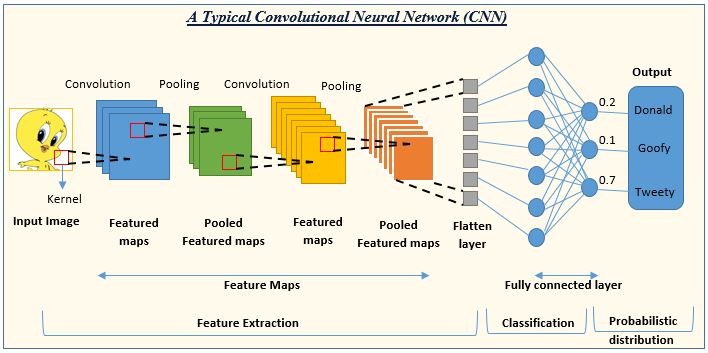
AI Atlas #16:
Convolutional Neural Networks (CNNs)
Rudina Seseri
🗺️ What are CNNs?
Convolutional Neural Networks (CNNs) are a type of machine learning architecture that is particularly effective at processing data that has a grid-like topology, such as images. They are designed to automatically learn and recognize patterns, shapes, and objects by going through multiple layers of specialized processing. These layers, called convolutional layers, extract features from the input data using filters that highlight specific characteristics. Through a process of learning and optimization, CNNs can classify images, detect objects, or perform other tasks related to visual understanding. They have been highly successful in tasks like image recognition, object detection, and image generation, and have been more recently applied to use cases beyond vision.
CNNs have several key components:
Convolutional layers extract features, patterns, structures, and characteristics, from the input data by applying filters that detect specific patterns or characteristics.
Pooling layers summarize and condense the information within specific regions of the input, helping to make the network more computationally efficient and robust to variations in the input.
Activation functions introduce non-linearity, the property of a function or system where the output is not directly proportional to the input, into the network, allowing it to learn complex relationships between the input and output.
Fully connected layers make the final predictions based on the learned features, connecting every neuron in one layer to every neuron in the next layer.
By combining these components and stacking multiple layers together, CNNs can learn hierarchical representations of data and complex patterns.
🤔 Why CNNs Matter and Their Shortcomings
Convolutional Neural Networks have numerous significant implications in Deep Learning including:
Superior performance in computer vision: The ability to learn hierarchical representations of visual data and capture complex patterns makes CNNs highly effective in analyzing and understanding images. CNNs have become state-of-the-art in computer vision in the domains of image classification, object detection, and image segmentation, among others.
Efficiency on large-scale visual data: CNNs are designed to handle high-dimensional visual data, with millions of parameters, in a computationally efficient manner. This has unlocked new use cases in computer vision that require the processing of millions of images or years of video.
Automatic feature extraction: CNNs have a remarkable ability to automatically learn relevant features from raw data. Through the convolutional layers, they can extract increasingly abstract and meaningful features at different levels of the network. This makes CNNs more versatile and adaptable to various tasks and datasets.
Leveraging transfer learning: CNNs can utilize pre-trained models on large benchmark datasets, such as ImageNet, and transfer the learned knowledge to new tasks or domains. Transfer learning allows CNNs to generalize well even with limited training data and accelerates the development of new models.
Applications beyond vision: CNNs have been successfully applied to domains such as natural language processing, speech recognition, drug discovery, recommendation systems, and more. Their ability to learn hierarchical representations and capture complex patterns makes them applicable in diverse fields of research and industry.
As with all breakthroughs in artificial intelligence, there are limitations to CNNs, including:
Difficulty in handling variations: CNNs struggle with variations in the input data, such as changes in rotation, scale, or translation. They may not recognize objects or patterns that appear differently from the examples they were trained on.
Limited understanding of global context: CNNs primarily focus on local features and may have difficulty capturing long-range dependencies or global context in the input. This can impact tasks where understanding the overall scene or context is important.
Lack of interpretability: CNNs are often seen as black-box models, meaning they lack transparency in how they arrive at their predictions. Understanding the reasoning behind their decisions or which features contribute to the output can be challenging.
🛠 Uses of CNNs
Convolutional Neural Networks are highly versatile and have numerous use cases including:
Image Classification: CNNs are widely used for image classification tasks, where they can accurately classify images into different categories, such as identifying objects in photographs or recognizing handwritten digits.
Object Detection: CNNs can detect and localize objects within images or videos. This is particularly useful in applications like autonomous driving, surveillance systems, and robotics, where identifying and tracking objects in real time is crucial.
Image Segmentation: CNNs can perform pixel-level segmentation, distinguishing different objects or regions within an image. This is valuable in medical imaging for identifying tumors or in computer graphics for background removal or scene understanding.
Time Series Analysis: CNNs can be used for analyzing time series data, such as sensor readings, financial data, or physiological signals. By treating the time dimension as a sequence, CNNs can learn temporal patterns and make predictions or detect anomalies in the data.
Speech Recognition: CNNs have been successfully applied to speech recognition tasks, where they process audio signals to recognize spoken words or transcribe speech. CNNs can learn to extract relevant features from audio spectrograms or waveforms, enabling accurate speech recognition.
Sensor Data Analysis: CNNs can process data from various sensors, such as accelerometers, gyroscopes, or temperature sensors. They can learn to recognize patterns or detect anomalies in sensor data, enabling applications in areas like Internet of Things (IoT), predictive maintenance, or activity recognition.
The future of Convolutional Neural Networks (CNNs) will likely include advancements in architectures that improve performance and efficiency including the development of deeper, wider, or more specialized network structures that can capture more complex features and patterns from data. Additionally, CNNs will likely extend their applications to new domains beyond traditional computer vision. As the understanding of CNNs’ capabilities grows, they may be employed in fields such as healthcare, robotics, autonomous systems, and scientific research for tasks involving diverse data types and modalities. Finally, research efforts will focus on improving the interpretability of CNN models to provide insights into their decision-making processes and thus opening up new use cases for CNNs where explainability is a necessary characteristic.